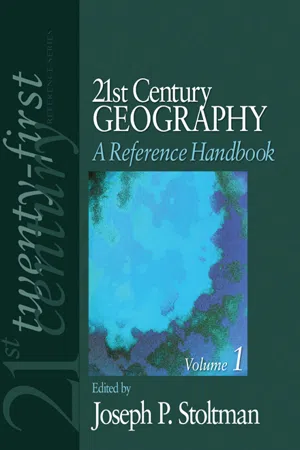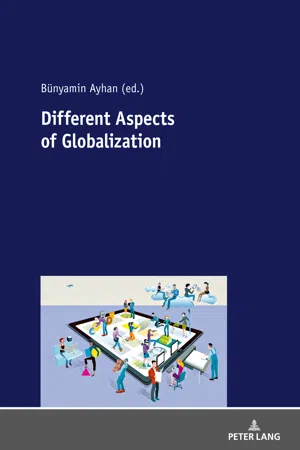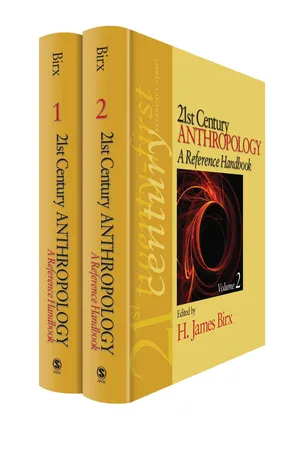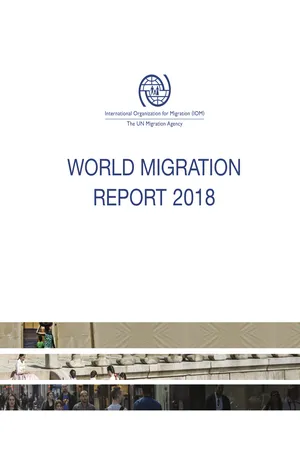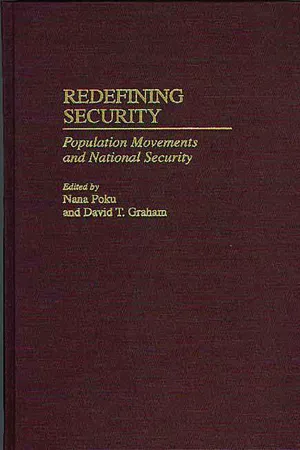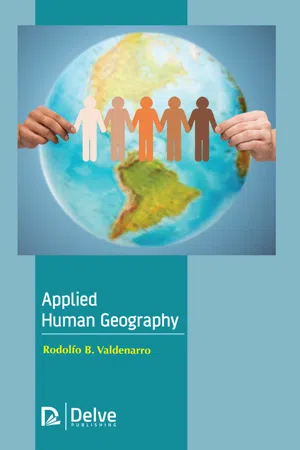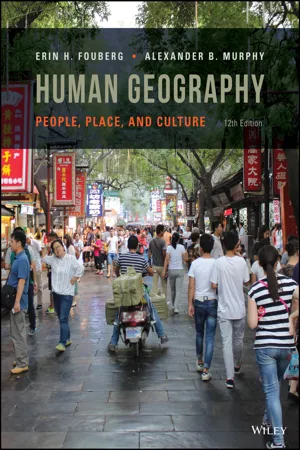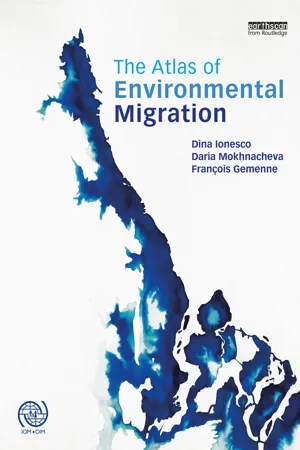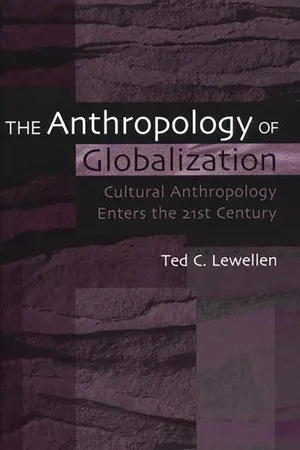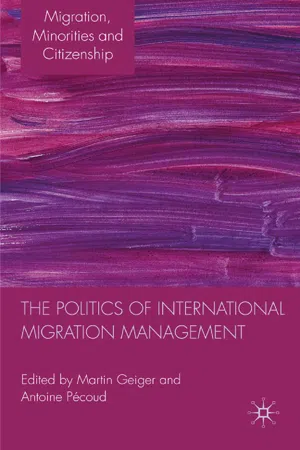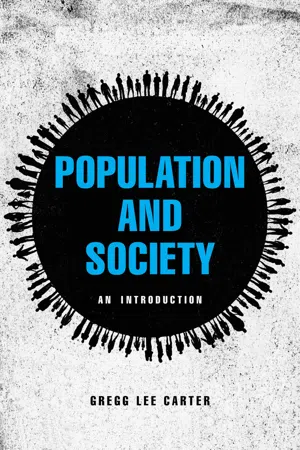Geography
Global Migration
Global migration refers to the movement of people across international borders in search of better economic opportunities, safety, or improved living conditions. It is a complex phenomenon influenced by factors such as economic disparities, political instability, and environmental changes. Global migration has significant impacts on both the countries of origin and destination, shaping demographic, social, and cultural landscapes.
Written by Perlego with AI-assistance
Related key terms
1 of 5
11 Key excerpts on "Global Migration"
- eBook - PDF
- Joseph P. Stoltman(Author)
- 2011(Publication Date)
- SAGE Publications, Inc(Publisher)
Migration involves people leaving a place (origin) and arriving at a new place (destination) under varying circum- stances. Migration is not pursued in isolation because the decision to migrate is linked to numerous push and pull factors. If City A has 30% unemployment and City B has a 5% or lower unemployment rate, it seems apparent that the economic hardship would act as the push factor to encourage people to leave City A and the opportunity (low unemployment rate) would act as the factor pulling people toward City B. There are intervening obstacles, which may impede migration, and that discussion is presented later in the chapter. Wherever there are movements of people, there are consequent demographic, social, and economic changes with spatial implications. Geographers study the spatial nature of movement and seek to derive the motives that people have for moving. The geographic contexts for 231 232 • HUMAN GEOGRAPHY migration occurs in multiple forms, such as people fleeing regions experiencing military conflicts, land-poor people settling new lands that are available for agriculture, or the mass migrations of Europeans moving to the Americas during times of religious, economic, and political repres- sion. These movements represent humans' quest for new beginnings and illustrate the migration phenomenon and restructuring of populated places in the world. Geography as a spatial discipline synthesizes and analyzes migration at different scales in the context of a place of origin and a place of destination. What Is Migration? What is migration? It can be defined spatially, based on where and how long individuals change their residential address domestically or internationally. Is the move perma- nent or semipermanent? Is it migration if a person moves from downtown Los Angeles to Hollywood? How about Mr. - eBook - PDF
- Bünyamin Ayhan(Author)
- 2018(Publication Date)
- Peter Lang Group(Publisher)
Asst. Prof. Namaitijiang Maimaiti*1 Asst. Prof. Doğa Başer**2 Lecturer Hasan Hüseyin Tekin***3 Globalization and Migration Introduction Migration is the movement of people from one place to another due to international pull and push factors. Migration can be permanent or temporary. The definition for migration will be different based on the migration period. Permanent migra- tion is when someone moves from one place to another and has no plans to return to their original home. Temporary migration is limited by time, and migrants will return to their homeland or move to another place. Migration is a process of social change during which a person moves from one cultural setting to another in order to settle for a longer period of time or permanently (Syed, 2003: 1). Giddens refers to globalization as the result of modernity and describes it as the condensation of worldwide social relations in which remote locations are associated with each other and local occurrences are shaped by events miles away (Arslanoğlu, 2000: 130). According to Steger (2013: 27), globalization means the creation of new social net- works and activities that are increasingly transcending traditional, political, cultural and geographical borders and the proliferation of existing ones. People may migrate from rural to urban areas, between neighboring countries or over longer distances; migration therefore covers a wide variety of processes (Bhugra, 2004: 244). The migration process includes conditions in the country of origin, during the journey, and in the recipient country. Migrants can be defined in various ways, e.g., as internally displaced, asylum seekers, refugees, or immigrants (Thomas, 2004: 117). It is difficult to distinguish between forced and voluntary migration; the reasons for migration often include both elements (Hjelde, 2004). - H. James Birx(Author)
- 2010(Publication Date)
- SAGE Publications, Inc(Publisher)
856 86 M IGRATION AND G LOBALIZATION M ARCIA B. D INNEEN Bridgewater State College T hroughout the history of humankind, people have migrated. From ancient peoples crossing oceans in wooden or even reed boats to entrepreneurs travers-ing the globe on jet planes, migration is part of human exis-tence. People have migrated to find food, safety, or shelter. They have migrated to flee enemies, to find work, or to practice their faith. Some migrations are local; others are within a country, across national borders, or from one con-tinent to another. Once viewed as a sign of crisis, migration is now viewed as a normal element of human society. In a 1959 paper delivered at the 11th International Congress of Historical Sciences in Stockholm in 1959, Frank Thistlethwaite wrote that migration is central to the general human pattern, essential for the functioning of families, and crucial to the operation of the labor market. He went on to state that migration streams are as much a part of the his-tory of the American people as Frederick Turner’s frontier policy. To study history is to take into account the causes and effects of migration. Continually, humans have looked to improve their lives by taking the often dangerous but always wrenching step of leaving their homes and seeking a new place to live. Some people experience several migra-tions in their lifetimes; others never leave their homes. Migration and Anthropology Just as migration is not a new human activity, the study of migration is not a recent concern for scholars. Social scientists have long recognized the importance of migration as a factor in social change. Geographers, historians, political scientists, sociologists, economists, and others have studied the causes and effects of migra-tion for years. In 1885, E. G. Ravenstein published his laws of migration; this is the earliest systematic study of migration.- No longer available |Learn more
- International Court of Justice(Author)
- 2017(Publication Date)
- United Nations Publications(Publisher)
When considered together, these numbers paint a concerning picture of migration and displacement globally, and more pointedly, they indicate that such large numbers of people moving (including under duress) are related in part to significant events, such as conflict in the Syrian Arab Republic. 8 The Global Migration picture must, therefore, be seen as a sum of many parts and it is important to put recent developments in specific regions into global and historical contexts. Migration corridors that have developed over time often have a foundation in geographic proximity, but they are also shaped by trade and economic factors, conflict and human (in)security, and community and ethnic ties, as well as smuggling and trafficking. Further chapters in this report examine these aspects, including by geographic region (see chapter 3); a global overview of migration and migrants is presented in chapter 2. Notwithstanding a natural tendency to focus on the challenges that migration presents, so that they can be better understood and therefore managed, it is well worth revisiting briefly what we know about some of the considerable benefits of migration. In a period of heightened internal and international displacement (and related irregular migration), the enormous benefits of migration can become somewhat lost in the debate. The need to rebalance considerations of migration has been recognized by many international organizations, and there has been a recent resurgence in critical examinations of the relationship between human development, economic growth and migration at the global level. Recent work by the IMF, McKinsey Global Institute and the OECD, as well as the ongoing work of the World Bank and regional development banks, highlight the importance of ensuring that we remain focused on the successes of migration as well as the challenges. Benefits of migration Migration can generate very large benefits for migrants, their families and countries of origin. - eBook - PDF
Redefining Security
Population Movements and National Security
- David T. Graham, Nana Poku(Authors)
- 1998(Publication Date)
- Praeger(Publisher)
6 The Globalization of Population Movements: Legal Migrants Graeme Hugo INTRODUCTION The last three decades have witnessed a number of parametric changes in the scale, diversity, spatial patterning, and impact of population movements between nations. This is of course a function of broader trends of globalization but also of increasing levels of education, penetration of mass media to all parts of the world, reductions in the real costs of travel, and increasing demographic and economic inequalities and differences between nations. It also has been facilitated by the proliferation of migrant social networks linking nations and the development of a global and regional immigration industry (Massey et al. 1993). Nevertheless, while capital and information flows freely between nations and barriers to those flows have been all but eroded away, the flow of people has been subjected to greater restrictions as nation-states attempt to control and limit the numbers and types of people crossing their borders. Accordingly, international migration can increasingly be categorized into two types: on the one hand where migrants go through official channels and enter a country with appropriate documentation and maintain this legal status throughout their stay in that country. On the other hand there are an increasing number of interna- tional migrants who, being denied legal entry, either enter a nation clandes- tinely or having entered a country legally, disobey the conditions of their entry by overstaying or engaging in activities—especially work—which were not permitted by the type of entry granted. This Chapter summarizes developments in recent decades in the first of those types of movement. INTERNATIONAL MIGRATION SYSTEMS While it is true that the explosion of international population flows has created networks linking each nation of the world with most other nations, it is clear that there are 'clusters' of nations that are strongly networked and among - eBook - PDF
- Rodolfo B. Valdenarro(Author)
- 2019(Publication Date)
- Delve Publishing(Publisher)
Migration: The Human Movement to Other Places 9 CONTENTS 9.1. Introduction .................................................................................... 184 9.2. Types Of Migration ......................................................................... 187 9.3. Components Influencing People To Migrate .................................... 190 9.4. Giddens’ Theory Of Structuration And Applications to Migration .... 192 9.5. International Migration Systems ..................................................... 193 9.6. Migration And Urbanization ........................................................... 197 9.7. Scenes of Development And Hazard ............................................... 199 Applied Human Geography 184 This chapter is concerned with migration of human population and its impact on geography. Man has engaged in migration for better opportunities since time immemorial. This chapter classifies migration into different types. It then describes the factors that influence people to migrate. The chapter then describes Giddens’ Theory of Structuration and the way it can be applied to migration. The chapter then talks about various aspects of international migration. The chapter then covers in detail how urbanization and migration are connected. Finally, it describes how migration can lead to development as well as certain hazards. 9.1. INTRODUCTION The development of gatherings and people starting with one spot then onto the next, including a difference in normal habitation. Relocation is normally recognized from versatility all in all by shows of spatial and transient scale. For instance, by show universal movement requires crossing a national limit for a real or planned time of in any event one year. Private versatility, paradoxically, may comprise of a short-separate move between properties in a similar city. Typologies of relocation separate among inner and universal movement, and the two structures are generally contemplated independently. - eBook - PDF
Human Geography
People, Place, and Culture
- Erin H. Fouberg, Alexander B. Murphy(Authors)
- 2020(Publication Date)
- Wiley(Publisher)
Most are migrants who reported average salaries of less than $150 a month. This chapter explores why people migrate, whether by force or voluntarily. We discuss where people migrate, both within countries and across country borders, and how governments impact migration. CHAPTER OUTLINE 3.1 Explain migration as a type of movement. • Cyclic Movement • Migration 3.2 Explain Historic and Modern Forced Migration. • Historic Forced Migration • Modern Slavery and Human Trafficking 3.3 Explain the Theories of Migration and Understand the Motivations for Migration. • Laws of Migration and the Gravity Model • Push and Pull Factors 3.4 Identify why refugees are a distinct group of migrants and describe where most refugees migrate. • Distribution of Refugees • Areas of Dislocation 3.5 Determine how government policies impact migration. • Waves of Immigration in the United States • Legal Restrictions Photo by A.B. Murphy. © 2020 John Wiley & Sons, Inc. FIGURE 3.1 Mumbai, India. A view from the top of a high-rise in the central city, looking at one of the slums found tucked between buildings throughout the city. The Census of India reports that more than 50 percent of the Mumbai’s residents live in slums. 3.1 Explain Migration as a Type of Movement 63 Migration is a type of movement that changes both the places migrants leave and the places they go. The movement of peo- ple along paths of migration creates connections and networks among places. Migration changes how people see themselves and others. It also increases spatial interaction and speeds the diffusion of ideas and innovations among places connected through migration. Geographers identify two basic types of movement. Leav- ing home for a defined amount of time and returning home is called cyclic movement. Migration changes the location of home and has a degree of permanence not found in cyclic movement. Migration is movement from a home location to a new place with an intent to stay in the new place permanently. - eBook - ePub
- Dina Ionesco, Daria Mokhnacheva, François Gemenne(Authors)
- 2016(Publication Date)
- Routledge(Publisher)
The number of international migrants has more than doubled over the last 30 years and, despite a slowdown following the 2008 global economic crisis, reached 232 million migrants in 2013, which represents around 3.3 per cent of the global population. This global figure, which measures 'stocks' of migrants in a given country at a given moment in time as recorded through national statistics and censuses, shows just one facet of the complex world migration patterns, and provides no indication as to the reasons for and nature of movements. Behind it lie various types of migration across borders, including labour migration, migration for education, refugee movements, family reunification, return migration, or retirement and amenity migration, some of which may also be linked to environmental factors. Accurate statistics by type of migration are seldom available, except when migrants fall into a clear legal category or benefit from special assistance, such as refugees or those benefiting from family reunification programmes, who are recorded by relevant national and international agencies, In most cases, however, migratory situations are complex, rarely fall into a single category, and may evolve over time, Furthermore, the global figure does not account for a number of migratory situations for which statistics are hard to obtain – typically the case of many forced forms of cross-border migration, including victims of smuggling and trafficking, and an exponentially growing number of irregular migrants. Quantifying these types of migration is challenging, due to their hidden nature, and only rough estimates are available for these flows. Finally, the global figure does not reflect seasonal, circular or other temporary movements, which may also include temporary cross-border displacement due to natural disasters.An age of mass internal migration
The focus of political discourse on international migration diverts attention away from one of the predominant forms of migration: internal migration within countries, driven by urbanization, economic and demographic dynamics, is estimated to greatly exceed international migration. This type of migration is difficult to quantify, as data availability and methodologies vary from one country to another. However, the United Nations estimates that there are 763 million people worldwide living within their country but outside their region of birth. Estimates also exist for internal displacement due to conflict and violence, which is monitored by the UNHCR and IDMC. - eBook - PDF
The Anthropology of Globalization
Cultural Anthropology Enters the 21st Century
- Ted C. Lewellen(Author)
- 2002(Publication Date)
- Praeger(Publisher)
PART II Globalization and Migration I have been a stranger in a strange land. Moses, Exodus 2:22 I can live anywhere in the world, but it must be near an airport. Chinese investor based in San Francisco (Quoted in Ong 1993: 41) This page intentionally left blank Chapter 6 Migration: People on the Move The changes in migration patterns are not merely matters of individual choice but rather reveal structural factors beyond the control of individu- als. James Mittleman 1 Thus, in the United States as well as in Mexico, the place of putative com- munity—whether regional or national—is becoming little more than a site in which transnational^ organized circuits of capital, labor, and com- munications intersect with one another and with local ways of life. Roger Rouse 2 There is nothing new about long-term, long-distance migration. At the turn of the 21st century, an estimated 100 million people live outside of their countries of original citizenship. 3 While this figure is impressive, it is less than 2% of the world's population, which means that, at any given time, 98% are staying home, or at least within their own national borders (Hammar and Tamas 1997: 1). Percentage-wise this is not historically un- usual, nor is it exceptionally significant in regard to world structural change. Archeologists tell us that our prehistoric ancestors migrated out of Africa, spreading through Asia and Europe, crossing oceans to the Ameri- cas and Australia. History is replete with mass movements, often based in military action, such as Alexander's conquests, Rome's policy of coloniza- tion, the spread of Islam, and the migratory conquests of Genghis Khan and his followers. After 1500, with the Industrial Revolution and the emer- 124 Globalization and Migration gence of Europe as a world colonizing power, we see a relatively different emphasis of mass migration, based more on labor needs than on conquest. - M. Geiger, A. Pécoud, M. Geiger, A. Pécoud(Authors)
- 2010(Publication Date)
- Palgrave Macmillan(Publisher)
Sara Kalm 33 (legal or illegal), which facilitate the actual movement and seem to defy any governmental regulative effort. The World Commission on the Social Dimension of Globalization regards the fact that international migration has increased despite a tightening of border controls in industrialized countries as ... clearly linked to increasing globalization. Declining costs of trans- portation and the advent of cheap mass travel have greatly reduced one important barrier to movement. The ICT revolution and the universal reach of the media have meant a vast diffusion of awareness of differ- ences in living standards between rich and poor countries that has added to the allure of migration. New market institutions have emerged which facilitate the process, in the shape of intermediaries and agents. (ILO, 2004a, p. 96) The recognition that migration is an integral part of globalization marks a breakthrough in the understanding of the relationship between migration and other dimensions of economic globalization. In the Washington Con- sensus period, the belief was that the incorporation of poor countries into the global market for trade would increase growth and eventually offset the need for migration among their populations (Massey et al., 1998, p. 284; Nayyar, 2002, p. 157). Thus, the belief was that economic liberalization could substitute for migration. In contrast, the current global policy discourse sees migration as ‘an integral feature of a rapidly globalizing world’ (IAMM, 2004, p. 23). Although the economic crisis may decrease migration temporarily, with its recovery ‘many of the same underlying trends that have been driv- ing movement for the last half-century will resurface, attracting more people to move’ (UNDP, 2009, p. 8). The understanding of cross-border migration as a natural activity also diverges from state system governance.- eBook - ePub
Population and Society
An Introduction
- Gregg Lee Carter(Author)
- 2016(Publication Date)
- Polity(Publisher)
In some cases, governments have forced the population transfer of a particular ethnic or religious group from one region to another; and in other cases, the chaos and dread associated with civil wars, insurrections, revolutions, and persecutions have created a situation of impelled migration, in which individuals, families, and groups flee their homes in search of safe havens – often involving the crossing of national borders. The following briefly developed examples, one historical and one contemporary, illustrate the importance of this macro factor in explaining geographic mobility. Note that such examples could readily be drawn exclusively from almost any and all of the individual histories of the world's current 195 countries. The Africa to the Americas slave trade
Index pages curate the most relevant extracts from our library of academic textbooks. They’ve been created using an in-house natural language model (NLM), each adding context and meaning to key research topics.
